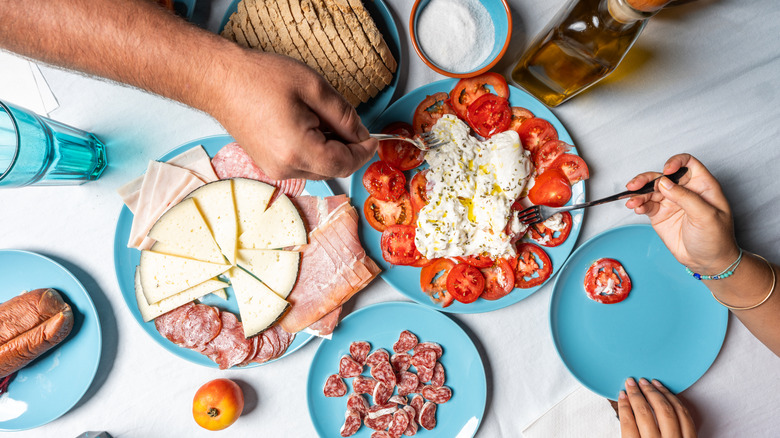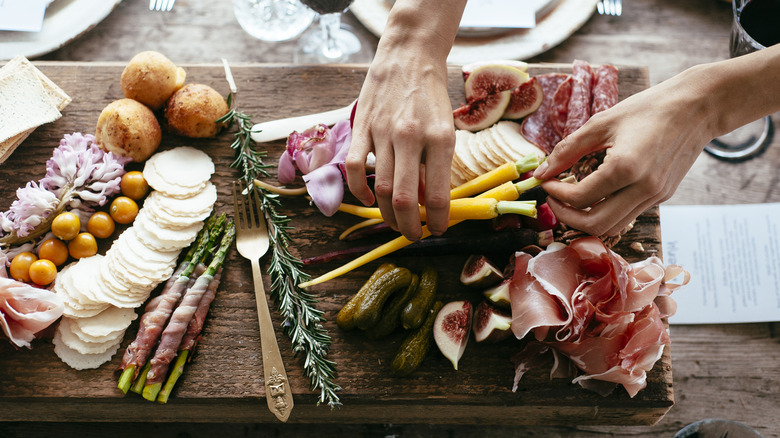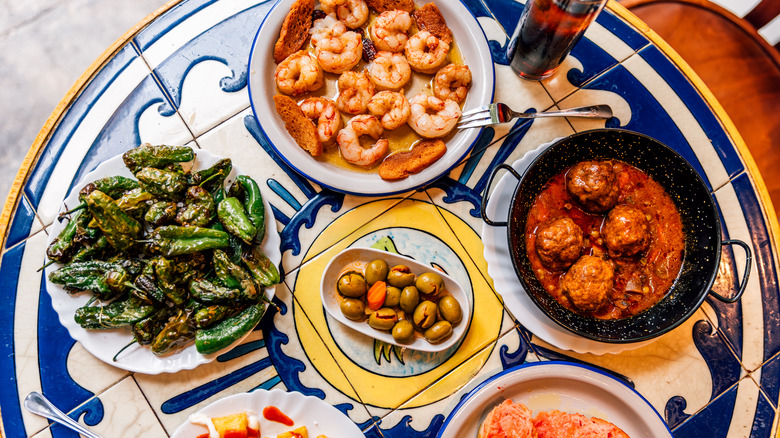Here's What You Can Expect When Ordering Tapas
Traditionally, when you go out to eat, you get your plate, whoever you're with gets their plate, and everybody minds their own meal. Not so with tapas. Some people are under the impression you get one big plate and everyone eats from it, but it's more like piecing together your meal from a bunch of small shared dishes. Tapas started in Spain centuries ago, originally as little snacks served with drinks to keep customers around longer.
The word "tapa" even means "cover" or "lid" in Spanish, because bartenders used to place the snack on top of your drink to keep flies out. When you order tapas, you're not just sitting down for a meal; you're hanging out, talking, passing plates, and trying a little bit of everything. Some dishes are simple, like plain olives or bread with olive oil. Others are more filling, like flavorful meatballs in tomato sauce or grilled shrimp.
You pick what sounds good and order a few at a time since it's casual. The best part is getting to mix and match and try some of everything at the table. If something disappears fast, you just order another round — you eat as much or as little as you want. I've seen people stretch the occasion out for hours. If you're with the right type of people, it really is a blast.
The food shows up whenever it's ready, not all at once
One thing you notice right away with tapas is there's no set order like in a traditional meal. You don't sit there and figure out how many appetizers to order for the group, then wait for a main course, then dessert. Instead, you get whatever dish is ready first. You might be munching on fried potatoes while someone else dives into shrimp or chorizo. Five minutes later, another plate drops on the table, maybe cheese and ham or grilled veggies. It feels a little chaotic at first, but that's the point. You skip that awkward period of staring at an empty table with water and bread while waiting for the food to arrive. You're always eating, always sharing, and always talking.
It keeps the energy going in a way that a normal sit-down dinner doesn't. In most places, they recommend ordering a few things first, seeing what you like, and then ordering more later. That way, the table doesn't get crowded and the food stays hot. It's not rushed, but it never stops moving either. It works best when you let go of the idea that everything has to happen in a certain order and just enjoy whatever shows up next.
Tapas can be simple or surprisingly fancy
Not all tapas are a conglomeration of fancy pants masterpieces. A lot of the time, it's just honest, simple food made really well (hopefully). Bread, olives, and a good piece of cheese are common as tapas. Fried calamari or little meat skewers might not sound fancy, but when they're cooked right, they really hit the spot. That said, there are plenty of restaurants that level it up. Some places serve things like slow-braised pork cheeks, mussels, or tiny plates of seared tuna, for example.
Other places stick with old-school Spanish classics, while others put their own spin on the genre. Either way, tapas give you variety because you're tasting different textures, flavors, and cooking styles without committing to anything. It keeps the meal fun, light, and open-ended. If you've never tried tapas, it's definitely a unique way to eat that takes some getting used to, but you may just surprise yourself with how much you like this more communal style of eating.


